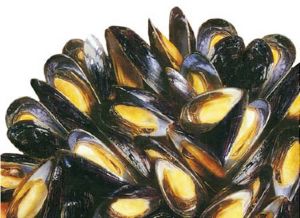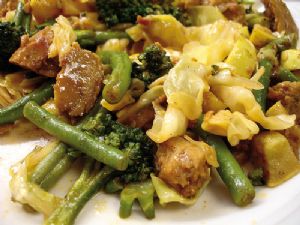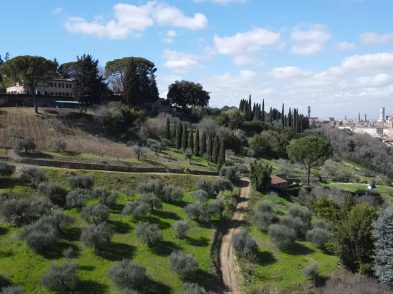I’d be lying
if I said that the topic of this fortnight’s article wasn’t inspired by the
ready crop of puns that suit anything bean-related. Bean a long time? The
importance of beans in earnest? Lentil we meet again? Pun-tastic. However,
at this time of year, when cash is still a bit tight after the excesses of the
holidays and the waistbands of trousers are even tighter, beans, lentils and
other pulses (the edible seeds of various members of the legume family) are
essential ingredients. It’s fortunate, then, that here in Tuscany they are an integral and long-standing part of
the local cuisine.
A word about food safety. The first thing that you need to remember
about beans, particularly the dried, uncooked varieties, is to read and follow
the instructions on the package or, if you buy in bulk, a cookbook. If the
beans need to be soaked for a specified length of time, do so. If they need to
be boiled for a certain length of time, follow the advice. Unsoaked beans
cooked incorrectly can be bad for you. If in doubt, soak them overnight in
plenty of cold water, drain and wash well, and then boil vigorously for 30
minutes before cooking in any other way. With some beans, such as red kidney
beans, you may need to change the water once during cooking, too. At the very
least, you’ll end up with soft beans that are less likely to split as they stew
and you won’t be poisoned by them. Lentils can generally be cooked directly
until tender, but again, please check the packaging.
Now you’re ready to start. Certain varieties of pulses are easy to come
by in this part of Italy, such as green lentils, or the bagged mixes of green,
brown, puy and red lentils for soups and stews. We favour green lentils on
their own, but try to find puy lentils, too. These are a darker green, and
speckled with light green-grey spots. Both types hold their shape and texture
when cooked and lend a delicious, meaty texture and a fine, almost musky
stock-like taste to stews, soups and salads.
Bean-wise,
you’ll find borlotti, cannellini and haricot beans by the tonne on the shelves
of your local supermarkets, as well as butter beans and chickpeas. Of course,
plenty of other imported or non-native types of beans, such as black beans, red
kidney beans, are also available throughout Italy, but let’s focus on the
locals first. Borlotti and cannelloni beans come into season in between late
summer and autumn, so at the moment you’re more likely to find dried or tinned
versions in the shops. Unless you’re using these as a principal ingredient in a
lightly flavoured salad, it’s unlikely that you’ll be able to tell the
difference from the fresh versions, so stock up.
Of course, you can use any of these in a stew, with plenty of tomato,
celery, onion, garlic, lemon juice and extra-virgin olive oil. Stirring a bit
of butter into this once it’s cooked on the stove top, transferring it to a
covered oven-proof pot, and then finishing it off by baking it will make it
extra-rich; stir in a bit of fresh parsley and some grated lemon zest at the
very end for extra oomph. Chickpeas and tomatoes, slow-cooked with lemon and
garlic, make an excellent accompaniment to grilled or roasted pork. Cannellini
beans cooked with toasted garlic and then stewed gently in chicken stock go
extremely well with any poultry dish. Slow-cooked haricot beans with as many
minestrone vegetables as you can get your hands on are good with fatty meats
like pork, rooster and duck.
However,
stewing isn’t the only way to use beans. They lend themselves perfectly to
purees: although you lose the textural complexity of the beans, a smooth,
creamy puree or mash brings the fullness of the flavours to the very front of
the dish. The paler and bigger the bean, the better it is to use in a puree.
Cannellini and butter beans are particularly good as purees. Cook until very
soft, drain and then blitz them with a hand blender, adding a little of the
water that they’ve been cooked in to loosen the mixture if it’s too thick.
Finish with a little olive oil and some seasoning: this is a great base for a
dish involving grilled meat or oven-baked or sautéed fish. Chickpeas are also
good, as proven by the existence of hummus.
Last but certainly
not least, pulses can be used in soups, either blended soups, for which you
should use cannellini beans, as they add a very delicate, creamy taste to
soups. Parsnip and cannellini bean soup is delicious. However, lentils come
into their own here: and for something a little different, try cooking lentils
in plenty of chicken stock with a teaspoon of curry powder, onions, garlic, and
a bay leaf. Spoon this soup into big bowls and dump a heap of fresh, chopped
parsley on each portion: finish with a bit of lemon juice if you feel like it.
Ideal for a cold winter’s day: nourish yourself on the broth, breathe in the
spicy steam and dream about the arrival of spring.
Ingredient of the fortnight: CHICKPEAS
Chickpeas, or ceci, are versatile enough to be used in a number
of dishes. They are a staple of Mediterranean cuisines, hence their appearance
in a lot of Spanish and North African dishes. In Italy, they are generally found
lurking in tins on the shelves or dried.
If you buy dried chickpeas and cook them yourself, the water that you
use makes an excellent vegetarian stock, so don’t throw it away once you’ve
drained the pulses. Cold cooked chickpeas are good in salads or blended with
garlic, tahini and oil to make hummus. If you do this, mash a couple up by hand
and stir them through afterwards for extra texture.
Pureeing chickpeas and adding a little of the water that you cooked them
with makes them an excellent accompaniment to grilled shellfish and other
seafood, particularly squid.
Recipe of the fortnight:
QUICK LENTIL CURRY WITH GINGER LASSI
1
onion, peeled and chopped
2
small carrots, peeled and chopped
220g
green lentils
1 tbsp
oil
1-inch
piece root ginger, peeled and chopped
440ml
water
2
cloves garlic, peeled and chopped
1 tsp
turmeric
2 tsp
curry powder
1 tsp
coriander
1 tsp
garam masala
1 tbsp
plain natural yoghurt
For the lassi:
2-inch
piece root ginger, peeled and finely grated
300ml plain
natural yoghurt
300ml
cold water
1
pinch salt
10 ice
cubes
Fry the onion, carrot, garlic and ginger in the oil until starting to
soften. Add the lentils and all of the spices except the garam masala. Stir
well, and then add the water. Cover and cook for 30 minutes, until the lentils
are soft and most of the water has gone. Stir 1 tbsp of yoghurt into the curry
and then remove from the heat.
In a large bowl, whisk together the yoghurt, salt and water for the
lassi. Add the ginger and stir well. Add the ice cubes and leave for five minutes.
Pour into tall glasses and serve with the curry and some rice.







